A Year of Shrubs for Howth
by Karl Flynn
This selection of shrubs is chosen specifically for the poor, thin, acid soils common on the upper parts of the Howth Penninsula. Two are selected to be at their best each month.
January

Daphne bholua “Jacqueline postill”
Originating in the eastern Himalayas, Daphne bholua forms an upright growing evergreen shrub with leathery mid-green oval leaves. ‘Jaqueline Postill’ produces intensely fragrant flowers which are pink on the outside and white within. It will thrive on any fertile free draining soils provided they are not too dry. It makes an ideal shrub for the small garden because it is quite slow growing and flowers during the late winter when most other plants are dormant. Daphnes hate transplanting and should only be pruned when absolutely necessary.

Garrya elliptica
Male forms of Garrya elliptica are impressive plants when laden with their long elegant tassels in winter and early spring. Female plants have much smaller catkins and clusters of round deep purple fruits in summer. ‘James Roof’ is the most popular variety because its tassels are much longer than the species, 20-30cm (10in)ong and lasting for many weeks, making a striking backdrop to other smaller plants. The shrubs are nominally hardy, although without the shelter of a warm wall some foliage might suffer wind scorch, and are unaffected by salt winds and city air. The Royal Horticultural Society has given it its prestigious Award of Garden Merit (AGM).
February

Mahonia japonica
A handsome species from China and Taiwan, although plants are now only found in cultivation, this is one of the most popular winter-flowering evergreen shrubs. It makes a bold, colourful highlight when its remarkable leaves, up to 40cm (16in) long, glow rich reddish-purple in the winter garden, followed before the spring by the long terminal clusters of lemon-yellow blooms which smell of lily-of-the-valley. Plants withstand shade, but need some protection from frost and wind to avoid leaf and bud scorch. Flowers last well in water when cut. The Royal Horticultural Society has given it its prestigious Award of Garden Merit (AGM).
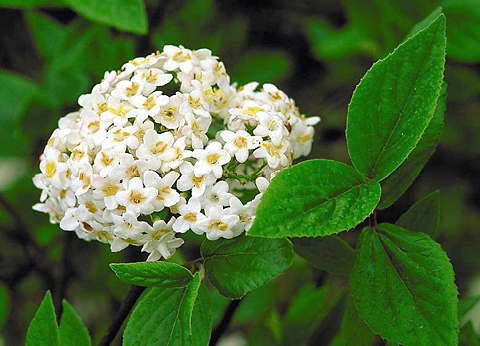
Viburnum x burkwoodii
Also known as X Osmarea burkwoodii, this high-quality shrub is a hybrid between two equally superb species, O. decorus and O. delavay, long cultivated as specimen shrubs and durable hedging. Their hybrid combines all their best qualities dense foliage and bushy growth, making a solid hedge or screen in less exposed gardens. Its attractive dark colouring is ideal as a background, and the white, pretty, jasmine-like flowers have a sweet fragrance that carries for great distances. Protect from cold north-east winds which can scorch the foliage. The Royal Horticultural Society has given it its prestigious Award of Garden Merit (AGM).
March

Magnolia stellata
This is the smallest magnolia and one of the most popular, growing very slowly into a rounded bush, 3m (10ft) high when mature but still only 1.2-1.5m (4-5ft) after ten years. It is fairly hardy, and frost can damage the grey furry buds and open flowers if they are exposed to morning sunshine. A position with early shade and sun later in the day is best. The beautiful flowers, pure white and lightly scented, open very early and before the leaves, eventually covering a mature shrub for several weeks. Plants tolerate lime, even pure limestone. This is one of the best magnolias for a small garden. The Royal Horticultural Society has given it its prestigious Award of Garden Merit (AGM).
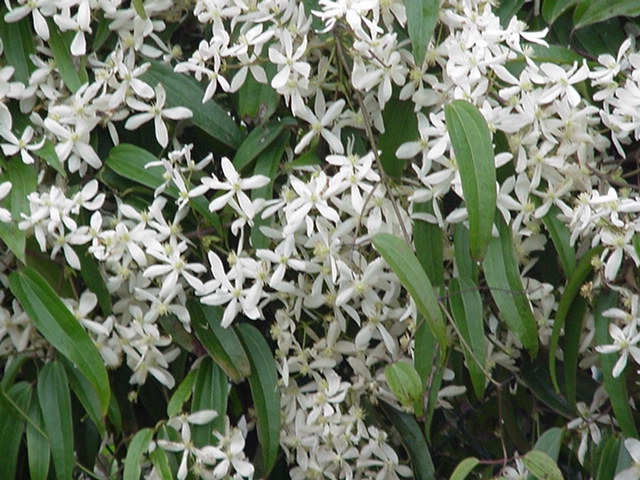
Clematis armandii
Clematis armandii is a tall climber (9 ft) with long evergreen leaves that are covered with fragrant white flowers in early spring
APRIL

Camellia cvs.
As long as they are planted in acid soil, camellias are not difficult to grow, and will even thrive in tricky semi-shaded areas, needing only minimal care once established. Most grow into large shrubs or small trees, but are extremely versatile and can be used as wall shrubs, hedges or superb container specimens.
For centuries, camellias have been popular in Japan and China, as can be seen on many of their works of art. Gardeners in Britain first grew these new plants in the early 18th century and by 1850, the camellia had become a prized ornamental shrub. Victorians loved the formality of the blooms and the elegant nature of the evergreen foliage. But, after the Victorian era, interest in camellias waned. Only in the 1950s did they become fashionable again, helped by the introduction of new varieties and species.

Chaenomeles cvs.
Chaenomeles x superba flowers very heavily and tends to grow wider than it is tall, an advantage when wall trained. A tough and very hardy shrub, popular for late winter and early spring colour in almost any situation in the garden. Plants flower best in full sun, but will give satisfaction in partial shade. ‘Crimson and Gold’ is more compact than other varieties and an excellent for training against a wall. It has very deep red flowers with gold yellow anthers, followed by heavy crops of fragrant fruits.
May

Abutilon vitifolium “Suntense”
Sun-loving shrub,grow against a warm wall for winter protection. Large blue flowers from May. Height up to 3 metre

Rosa “Canary Bird”
Rosa xanthina ‘Canary Bird’ is one of the earliest roses to flower in the gardening year. Pale yellow, scented flowers are produced on arching stems in mid-late spring. There is often a second flush of flowers in late summer.
June
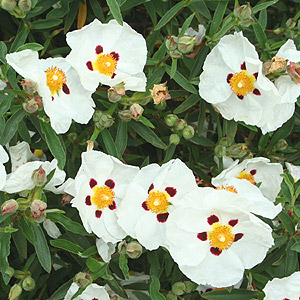
Cistus cvs.
It is hard to imagine a plant more deserving of a place in the early summer garden than cistus, or the sun rose. As tulips lose their shape and the apple blossom goes over, cistus comes into flower and, along with peonies, help to bridge the flowering gap until roses begin in earnest in mid-June. And what flowers they are. Single, flat and saucer-shaped, with five thin petals, they are creased like tissue paper when they first unfold and come in either white or shades of pink, depending on the variety. Each lasts for only one day, but the plant is so covered in buds that you can depend on new ones opening daily over at least a three-week period.
There are 20 or so species of cistus, all of which are evergreen shrubs. They come originally from the Canary Islands and countries bordering the Mediterranean. Cistus ladanifer, the gum cistus, is a generally hardy, upright shrub, growing to 2m by 1.5m (6.5ft by 5ft) if planted in a favoured spot, such as a south-facing wall border. Ladanum, a commercially extracted gum, comes from this species. The shoots are sticky and the imposing leaves are dark green and lance-shaped. The flowers, which measure 10cm (4in) across, have yellow stamens in the centre, surrounded by five distinctive, deep crimson-red blotches, which look like dried blood. The flowers are carried singly at the end of sideshoots in May and June.
Plants named Cistus ladanifer in garden centres and catalogues often turn out to be the similar but better-shaped cultivar, ‘Paladin’ or C. ladanifer var. sulcatus (formerly C. palhinhae). C. ladanifer var. albiflorus, which you may come across in specialist catalogues, is a form without the red spots on its petals.
One of the best forms for the non-specialist to try is Cistus x cyprius. This hardy hybrid of C. ladanifer and C. laurifolius is an excellent garden plant. Its flowersare similar to those of C. ladanifer, but they are carried in groups at the end of shoots. The leaves are bright green and aromatic. In time, this rounded shrub will grow to about 2m by 2m (6.5ft by 6.5ft). Cistus x dansereaui is similar to C. x cyprius, but grows to only about 1m high and across, making it ideal for small garden. It also has slightly smaller flowers. There is a form called ‘Decumbens’, which grows to only 60cm (24in), and also one called, variously, C. x dansereaui ‘Albiflorus’ or ‘Portmeirion’.
July

Romnea coulteri
The gorgeous fragrant flowers of the tree poppy make it a deserving holder of the Royal Horticultural Society’s prestigious Award of Garden Merit (AGM). Blooming for months on end in summer, it is a beautiful choice for a sunny, protected spot in well-drained soil. Plants can prove tricky to get going as they resent transplanting but once established they will spread rapidly. Protect plants with a dry winter mulch and cut back to a low permanent framework each spring.
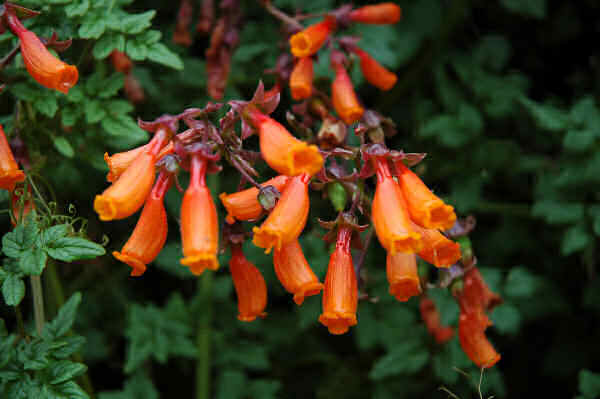
Eccremocarpus scaber
The Chilean glory flower is an exotic-looking climber with wiry stems and sparse, dark, evergreen foliage which acts as a perfect backdrop to the bright red, orange or yellow tubular flowers, which appear from early summer into autumn. Its speed of growth provides a useful screen for the bare bases of climbing roses, or to disguise the balding lower areas of conifers. The plants are not hardy but in mild regions they may survive – dying down in winter and reappearing larger and stronger the following year. In very mild, sheltered areas the foliage may remain all winter. Otherwise they should be treated as annuals. The Royal Horticultural Society has given it the Award of Garden Merit (AGM).
August
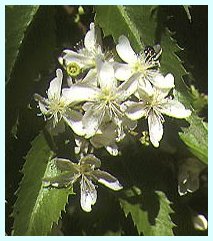

Perovskia “Blue Spire”
Sometimes called Russian sage, this sub-shrub produces soft grey-green foliage on white stems. The flowers resemble spikes of blue lavender. This variety has larger flower-heads and is an impressive plant, even in winter when bold groups of the white stems make an attractive feature. The deeply cut foliage smells strongly of sage when bruised. The Royal Horticultural Society has given it the Award of Garden Merit (AGM).
September

Indigophora geradiana
Indigofera Gerardiana grows between 3 feet high and 3 feet spread or 0.9 x 0.9 metres.
This flowering or fruiting shrub produces flowers in Summer. If you have a hot and dry area (eg South and West facing) protected from rain this is an excellent shrub to use in such a garden environment. Deciduous and loses leaves in Winter Hardy and will tolerate frost unless very severe.
Plants like this enjoy humus or organic rich soil. The organic matter not only feeds the flowers and leaves but also retains moisture for the plant. Garden plants like this one are pruned to create interesting plant shapes to act as specimen

Clematis tangutica
A species clematis that needs plenty of room. In late summer, the stems are decked with dangling yellow lantern like flowers, and as the first ones go over they are replaced by large, fluffy, white seed-heads. By late summer both flowers and seed-heads are present on the plant at the same time, which doubles the effect. As with all the late-flowering clematis, pruning is easy. Simply cut back the stems to a pair of strong buds 15-20cm (6-8in) above ground level before growth begins in early spring. This pruning technique makes late-flowering clematis useful for training into shrubs, trees and climbing roses as the clematis growth is removed each spring and so never becomes too much of a burden on its supporting plant.
October


Mutisia illicifolia
A superb climbing plant with leathery, dark green leaves, Holly-like but ending in a long, slender tendril. The most attractive flowers, between 2 and 3 ins. across, are pale pink to mauve in colour. Although practically hardy, the plant is perhaps best grown in a cool (or even cold) greenhouse when it will be almost continuously in flower.
November
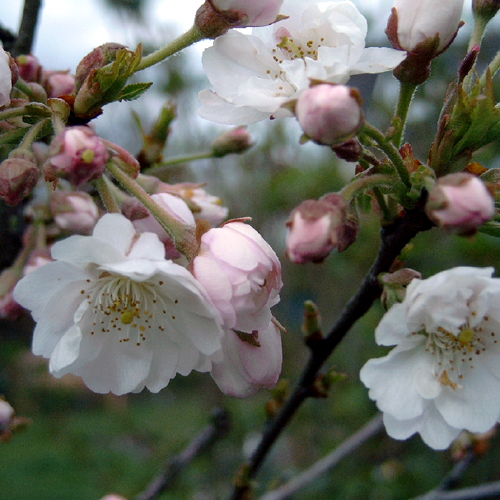
Prunus subhirtella “Autumnalis”
A broad, spreading, deciduous tree, Prunus x subhirtella ‘Autumnalis’ is capable of reaching a height of 8m (26ft) at maturity, but usually attains rather less. The leaves are 7cm (2¾in) long, oval and sharply toothed. The flowers are pink in bud, semi-double, 1cm (½in) across, pendulous, held in small clusters and white when fully opened, although they acquire pink tones as they fade.
Unlike spring-flowering cherries, ‘Autumnalis’ flowers in flushes between November and March or even April, only being temporarily halted by cold weather. This tree is frequently to be found in lists of plants flowering in public gardens on New Year’s Day. The flowers are not profusely carried but, nevertheless, look good against a blue sky, and gladden the heart when there is so little else of colour in the garden.
The autumn leaf colour is also rather better than in many other ornamental cherries. And these trees are also extremely hardy. For example, they grow well along the burn at Kailzie Gardens, near Peebles in the Scottish Borders, which is 210m (700ft) above sea level and experiences comparatively harsh winters.

Jasminum nudiflorum
A popular and reliable shrub, introduced from China in 1844, and widely grown as a wall shrub. It can be allowed to scramble freely over a low wall or up a bank, or trained up a vertical framework. Unlike many other jasmines, winter jasmine does not twine, so will need tying-in if grown vertically. The stems are bright green and give an evergreen impression, even in winter when the tiny bright yellow blooms appear, weatherproof in all but the coldest snaps. Regular pruning keeps bushes under control and prevents bare patches from appearing. The Royal Horticultural Society has given it the Award of Garden Merit (AGM).
December

Ilex “Golden King”
Glossy leaves with grey-green mottled centres and bright, golden-yellow margins. Despite its confusing name this compact, evergreen shrub is a ‘female’ variety of holly producing reddish-brown autumn berries that ripen to red. One of the best golden variegated hollies, it’s a great specimen plant for a sunny shrub or mixed border. Supplied in a 2-3 litre conatiner at a height of 40-60cms.
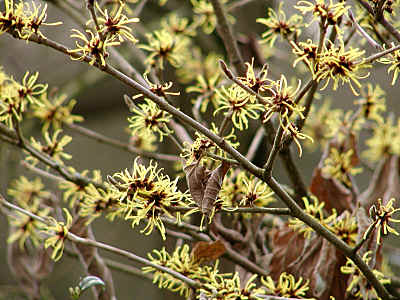
Hammemellis mollis ‘pallida’
This hamamelis produces large, sulphur-yellow blooms with a delicate, sweet scent. They seem to glow in winter light.
